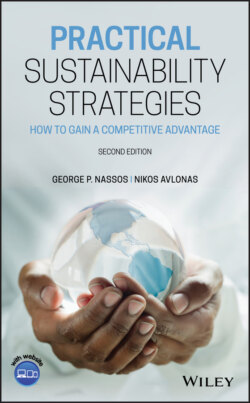Читать книгу Practical Sustainability Strategies - George P. Nassos - Страница 16
THE LIMITS TO GROWTH
ОглавлениеIn 1972, a team of MIT experts wrote a report titled The Limits to Growth and presented it to scientists, journalists, and others and shortly published it as a book. It was the first time that computer modeling was used to answer the question as to whether the population would outgrow the planet and the resources available. The purpose of the study was to show the interrelationship between global growth factors like population, resources, persistent pollution, food production, and industrial activity. Based on this study, they predicted that if human beings continued to consume more than the environment was capable of providing, there would be an economic collapse and a sharp decline in population by 2030, which is not too far away.
This topic of overshoot and collapse was addressed again in “Limits to Growth: A 30-Year Update” [9], which stated that “overshoot can lead to two different outcomes. One is a crash of some kind. Another is a deliberate turnaround, a correction, a careful easing down. We explore these two possibilities as they apply to human society and the planet that supports it. We believe that a correction is possible and that it could lead to a desirable, sustainable, sufficient future for all the world's peoples. We also believe that if a profound correction is not made soon, a crash of some sort is certain. And it will occur within the lifetimes of many who are alive today.”
Although the 1972 report seemed to focus on a very negative scenario, they looked at various changes that could avert a collapse. One positive variable was looking at technological changes that increased agricultural productivity, reduced pollution, and provided an increase in the available supply of natural resources. Technological advancements would have a positive impact, but this alone could not avert a collapse. Social and cultural changes would also be necessary to reduce consumption and stabilize population growth. Since it had been 40 years since the report, data were collected and compared with the predictions. To mark the 40th anniversary of the report, experts gathered to discuss the challenges ahead to into a sustainable future. Their concern was depicted in Figure 1.1 [10], which shows that the world is following the predictions of the study.
FIGURE 1.1 Limits of growth.
You can see that with 30 years of data, pollution, industrial output, population, and services per capita are all increasing as expected. At the same time, the remaining non-renewable resources are decreasing a little slower (good), but food per capita is increasing a little faster than expected (bad).
The study was also concerned with sustainable development, which was defined by the notion that the developed nations can keep what they have while the poor people try to catch up. Or perhaps, keep on doing what we are all doing but through technological advances, we can expect less pollution and use fewer resources. Unfortunately, we are not succeeding with this expectation. We are currently consuming 70% more than what the earth is able to provide as explained earlier by the ecological footprint.
What we are consuming can be described as the different forms of industrial capital. This capital really refers to the machines and factories that produce the manufactured goods. These products manufactured by the industrial capital can be defined as industrial output. This industrial output derived from industrial capital can be used to generate service capital for the service industry, like banks, schools, and hospitals, which provide services for the people. Industrial capital is also converted to agricultural capital to generate agricultural output. Likewise, it is converted to resource-obtaining capital to generate resource output. In addition, industrial capital is used to manufacture consumer goods. As each of these industrial outputs continues to grow, there is a need for more capital to be invested in the factories and machines that serve each of the outputs. Consequently, there may be an exponentially growing requirement for industrial output to expand the capacity for production in the future. This leads to more and more consumption.
